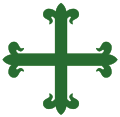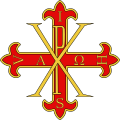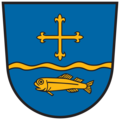Lily cross
With the lily cross , all four crossing arms are covered with the mostly stylized lily above and directly form the cross. Because the lily that sits on a staff is called glaive - from the polearm glefe - one also speaks of glaive cross . Whether it is described as such is less a question of the exact representation than of the origin or meaning of the sign. The lily cross is particularly used in heraldry . Here it is known as a common figure .
Forms and history
In the Christian meaning, this form of the stylized lily stands for the trinity because of the threefold separation .
The shape of the middle sheet ranges from oblong-lanzettfömig floral pronounced leaf shapes in relation to the flowering of lilies , with far-back side-scrolling, to which the blade of the glaive nachgestalteten forms, and can also be replaced by forms like a cross.
Order of knights
It was donated in 1156 to a Castilian military order as a sign of the order. It is the order of knights of Alcantara . This cross is colored green. The Cross Order of Calatrava is colored red. Both crosses are also referred to by the name of the order: Calatrava cross and Alcantara cross .
Constantine Cross ( IHS V, Chi-Rho , Alpha and Omega )
Inquisition and Church Heraldry

Since the 14th century it was the emblem of the Inquisition , and from there it is also transferred to the coat of arms of the Dominicans (who also use the coat of arms , the tip ). In the heraldic sense, the Dominican cross is a raised lily end cross.
Modifications
- If a cross arm is pointed, it is referred to as a lily cross , for example in red the Jacob's cross . The arm forming the tip points downwards and is often significantly longer than the other arms.
- If the cross is placed as a slope , it becomes a lily cross .
- If the cross arms are extended, the lily end cross is created . Here the stylized lilies are only used as ornaments at the ends of the cross.
- In the lily cross, the ends of the arms mostly merge into the three upper leaves of the lily without a ribbon, with a ribbon in the coat of arms of Broitzem and the southern Eifel community . A cross with full lilies can be found in the arms of those of Broizem .
Examples
At Écu au soleil , Paris, 1498
In the district coat of arms of Heinsberg
Coat of arms of the Verbandsgemeinde Südeifel
Web links
Individual evidence
- ^ William M. Hinkle: The Fleurs de Lis of the Kings of France. 1285-1488. Southern Illinois University Press, Carbondale IL et al. 1991, ISBN 0-8093-1676-5 , pp. 1-31.
- ↑ Article: Which coats of arms do the Dominicans use from May 16, 2008 on medals, accessed online on February 13, 2016.
- ↑ Walter Leonhard: The great book of heraldic art. Development - elements - motifs - design. Bechtermünz, Augsburg 2003, ISBN 3-8289-0768-7 .










